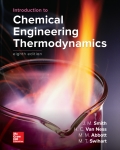
(a)
Interpretation:
To determine an expression for mass flow rate of water
Concept Introduction:
Since water is flowing through nozzle and mass of water is coming and going, so it must be an open system. For an open system steady state flow, the energy balance is therefore,
Where
And the relation between mass flow rate
Here, Area
(a)
Answer to Problem 2.48P
The mass flow rate of water
Explanation of Solution
Given information:
It is given that water is flowing with conditions steady state flows, incompressible fluid, isothermal process and adiabatic process and for water at constant temperature.
The inlet pressure
For steady state flow;
So, the resultant energy balance will be
After rearranging,
Where
For adiabatic and no work shaft process and incompressible flow, the heat transfer, work shaft and potential energy term in equation (1) shall be zero.
Hence
Put
Rearranging
Rearranging and Hence the final solution will be
(b)
Interpretation:
To determine the effect of temperature change on an expression for mass flow rate of water
Concept Introduction:
Since water is flowing through nozzle and mass of water is coming and going, so it must be an open system. For an open system steady state flow, the energy balance is therefore,
Where
And the relation between mass flow rate
Here, Area
(b)
Answer to Problem 2.48P
The mass flow rate of water
Explanation of Solution
Given information:
It is given that water is flowing with conditions steady state flows, incompressible fluid, non thermal process with
Here
The inlet pressure
For steady state flow;
So, the resultant energy balance will be
After rearranging,
Where,
For adiabatic and no work shaft process and incompressible flow, the heat transfer, work shaft and potential energy term in equation (1) shall be zero.
Hence
Put
Rearranging
Rearranging and Hence the final solution will be
Want to see more full solutions like this?
Chapter 2 Solutions
EBK INTRODUCTION TO CHEMICAL ENGINEERIN
 Introduction to Chemical Engineering Thermodynami...Chemical EngineeringISBN:9781259696527Author:J.M. Smith Termodinamica en ingenieria quimica, Hendrick C Van Ness, Michael Abbott, Mark SwihartPublisher:McGraw-Hill Education
Introduction to Chemical Engineering Thermodynami...Chemical EngineeringISBN:9781259696527Author:J.M. Smith Termodinamica en ingenieria quimica, Hendrick C Van Ness, Michael Abbott, Mark SwihartPublisher:McGraw-Hill Education Elementary Principles of Chemical Processes, Bind...Chemical EngineeringISBN:9781118431221Author:Richard M. Felder, Ronald W. Rousseau, Lisa G. BullardPublisher:WILEY
Elementary Principles of Chemical Processes, Bind...Chemical EngineeringISBN:9781118431221Author:Richard M. Felder, Ronald W. Rousseau, Lisa G. BullardPublisher:WILEY Elements of Chemical Reaction Engineering (5th Ed...Chemical EngineeringISBN:9780133887518Author:H. Scott FoglerPublisher:Prentice Hall
Elements of Chemical Reaction Engineering (5th Ed...Chemical EngineeringISBN:9780133887518Author:H. Scott FoglerPublisher:Prentice Hall
 Industrial Plastics: Theory and ApplicationsChemical EngineeringISBN:9781285061238Author:Lokensgard, ErikPublisher:Delmar Cengage Learning
Industrial Plastics: Theory and ApplicationsChemical EngineeringISBN:9781285061238Author:Lokensgard, ErikPublisher:Delmar Cengage Learning Unit Operations of Chemical EngineeringChemical EngineeringISBN:9780072848236Author:Warren McCabe, Julian C. Smith, Peter HarriottPublisher:McGraw-Hill Companies, The
Unit Operations of Chemical EngineeringChemical EngineeringISBN:9780072848236Author:Warren McCabe, Julian C. Smith, Peter HarriottPublisher:McGraw-Hill Companies, The





